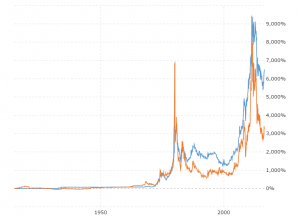Gold and Silver Return as Legal Tender
It was only in 1933 that you could no longer redeem your bills and coins for their gold equivalent. For centuries coins contained their value in gold – a $1 gold coin contained $1 worth of gold. When the value deviated significantly upwards, so that a coin contained more than its face value in precious metals, people simply melted them down and sold them as gold or silver, realizing a profit. That all changed when the US Mint was no longer legally obliged to convert bills for gold, and vice versa, and of course today most circulation coins are made of base metals, with a melt value well below their face value.
However, the Mint still issues gold coins, and since 1986 the American Eagle gold and silver bullion coins have been legal tender. Of course, it would be unwise to pay a bill with these coins, since their denominated value is substantially below the value of the gold in them. For example, the American Eagle gold coin contains one ounce of gold, valued today (06/17/19) at around $1,345. But the face value of the coin is a mere $50, so who would use this as legal tender? Yet several states have recently passed laws making these coins legal tender for buying goods. We ask ourselves, why?
The answer is in the distrust of many people in fiat currency. It is the same reason people hoard gold and silver – not just for some future possible Apocalypse, but because they cling to the idea that only precious metals are ‘real’ money. ‘Fiat’ money – coins and bills that are given an arbitrary value and depend on our mutual acceptance of that value – are seen by many people as the cause of our economic woes. While they do seem to forget that there were economic cycles and crashes during times when gold was legal tender, these supporters of gold have succeeded in getting several states to pass laws making gold legal again. Most recently, Wyoming passed House Bill 103, the Wyoming Legal Tender Act, which made gold and silver ‘specie’ legal tender. ‘Specie’ are all coins with gold or silver content, as well as pure bullion coins. Alabama has similar laws, and Wyoming and Kansas are also creating similar laws.
If we dig a little deeper though, the real motives here seem to be two-fold. The Wyoming law also removed all taxes on the sale of gold, while in Wyoming there is a requirement for the state to diversify its financial holdings into precious metals. The argument goes that the government, by taxing sales of coins, is treating them as commodities, not money. Using money cannot be taxed, otherwise you could pay a tax when you changed $5 bills into coins at your local bank. This is the real battle – an attempt to encourage the use of metals for exchange, and to undermine the Federal Reserve. A deeper purpose is to take away from the Federal Reserve their monopoly on money, so that states can issue their own currency, and perhaps people will return to using gold and silver for exchange. If successful, we might see a return to a time when a quarter was literally a gold dollar cut into four parts.
Whether these activists, like the Sound Money Defense League, can turn back the clock remains to be seen. In one direction we have a desire for real money, and in the other direction we have Bitcoin, and virtual money – who will win out?








